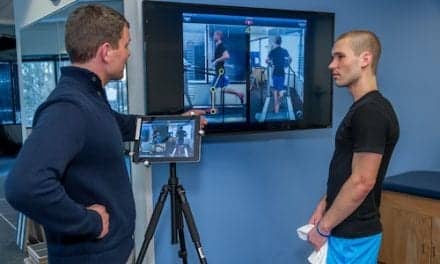Therapy pools are a single tool that provides multiple solutions for individualized recovery programs.
By Erin Allen, MSPT, MSCS, and Barbara Cacia
Data from the Centers for Disease Control and Prevention indicate that stroke kills almost 130,000 persons in America each year, making it a leading cause of death. However, not every stroke event is fatal. About 665,000 individuals survive a stroke, but have to live with the after-effects, which can sometimes be considerable. While the majority of strokes happen to men and women who could be considered older adults, a full one-third of the incidences occur to persons younger than 65 years of age. For physical therapists who treat stroke patients, this can make it a challenge to find effective, proven treatment methods that work for all ages and abilities.
Aquatic Therapy for Stroke Rehabilitation
One medium that has consistently worked well for stroke patients who come to the Pieters Family Life Center, Rochester, NY, has been aquatic therapy. The belief among staff is that each patient needs and deserves to be evaluated and helped on an individual basis, which is left to the discretion of the physical therapist as well as the prescribing physician. If aquatic therapy is recommended instead of, or in addition to, land-based therapy, it is always available on-site. The facility has invested in an advanced, warm-water therapy pool with a height-adjustable underwater treadmill floor. This therapy pool provides the opportunity to work with those who have lost specific abilities caused by stroke, such as movement on one side of the body, which affects ability to enter and exit the pool safely and comfortably.
Several manufacturers provide hydrotherapy pools to the PT marketplace. The HydroWorx 2000, from Middletown, Pa-based HydroWorx, includes the features described above, offers an underwater camera, and can accommodate up to four users during conditioning sessions or treadmill therapy. The HydroWorx 3500 can be configured with up to two underwater treadmills and provides multiple water depths so therapists can treat several different patients who are in different stages of weight-bearing.
Fall River, Mass-based SwimEx is the provider of a pool line that is designed to offer comprehensive isokinetic aquatic therapy and rehab. Most SwimEx open space and workstation models accommodate installation of the Woodway Integrated Motorized Treadmill for conditioning and rehabilitation protocols. Endless Pools, Aston, Pa, is also a manufacturer of aquatic therapy products, and offers a 10-foot exercise spa outfitted with an underwater treadmill and resistance current.
Stroke patients may not be moving enough or getting enough input from their bodies; the water supports them and affords them the chance to get moving and achieve functional goals. In most cases, putting someone with balance issues in the water is much easier on both the patient and the physical therapist than it is on land. Not only is the water a soothing environment, it is also consistently forgiving. The natural buoyancy of the water offsets the patient’s weight, making his or her fear of falling over less likely, as well as less psychologically worrisome. As the patient progresses, the level of buoyancy they experience can be adjusted by moving the floor of the pool. The physical therapist can be alongside the patient in the water and provide additional support.
Complementary to Land-Based Physical Therapy
Eventually, land-based physical therapy can be introduced in tandem with aquatic therapy as the person becomes stronger. An example of the power of aquatic therapy to help an individual make strides on land is the case of one of the facility’s participants. She experienced a stroke and was discouraged by her land therapy because she felt it was too difficult. Aquatic therapy opened the door for her to begin making progress in a more “forgiving” environment (and one in which her husband could don bathing apparel and join her during her sessions to allay her concerns and provide immediate support). Eventually, she came to call the therapy pool atmosphere “holy water,” a reference to what she felt had been a miracle and blessing for her.
In this patient’s case, aquatic therapy gave her the emotional energy to push through the barriers her stroke incident had created. Today, she walks about 25 minutes on the underwater treadmill and continues to make gains in strength and stability. She’s even walking with an assisted device on land, rather than being forced to use a wheelchair. Plus, she’s been able to resume land-based physical therapy, which has led to gains in other areas, including the ability to complete day-to-day activities. In addition, she has transitioned to a fitness class for the social benefits. Whereas she felt isolated before due to her condition and limitations, the aquatic therapy program in which she participates has opened new doors for her to make friends and improve her quality of life.
Aquatic Exercise for Brain Redevelopment
Aquatic therapy can provide an extremely effective avenue for helping stroke patients “retrain” their brains.
Stroke events affect the brain’s impulses in negative ways. In essence, those impulses stop firing correctly and therefore do not “talk” with one another as they once did. If “rewiring” of the neural pathways can be facilitated, therapists can help a stroke patient regain movement. In an aquatic therapy pool, many areas of a patient’s brain (eg, central nervous system, motor cortex) are stimulated by the immediate responses of the engaging physical activity. As those areas are stimulated, the patient’s brain can re-establish connections (primarily those which are motor connections).
One curious and often frustrating aspect of stroke is that all incidences are quite unique to the patient. The physical therapist cannot be entirely clear what movement must be relearned. Consequently, aquatic therapy is an excellent way to challenge the individual from many perspectives. Water exercise is truly exercise for the brain.
For example, we often say that “life begins at the pelvis.” This isn’t simply a tongue-in-cheek remark; the human core, the pelvis, is the first area we seek to strengthen with stroke patients treated at this facility. By adjusting the water depth in a specialized aquatic therapy pool, therapists are able to help develop patients’ core strengths and gradually move to working other muscle groups.
Exercise for Success
Every aquatic therapy success story begins with the multitude of exercises the physical therapist chooses to introduce. Many of the exercises routinely used during aquatic therapy have foundations in land-based therapy, and have just as much application in a water-based setting. From standing exercises to balance training, and gait training to treadmill training, land motions can be replicated to build physical strength and stamina. At the same time, patients often report a surge in emotional self-esteem and confidence, as well as a renewed desire to get well and feel healthier.
Therapy pool accessories can also be useful for stroke patients, although which accessory will work best depends upon the patient. If an individual has little muscle control over a leg, for example, it might make sense to weigh down that leg for the first few months of treatment sessions. Eventually, the weight can be removed as the patient is able to keep the leg from floating.
Another pool item used often is a water dumbbell. These can be utilized to encourage stability and improve upper body strength. Pool “noodles” can be placed around the midsection if the patient has a great deal of trouble staying upright. Again, each peripheral item should be used with the end result in mind. Noodles as well as bells that offer varying levels of resistance are available from many sources, including San Luis Obispo, Calif-headquartered Sprint Aquatics.
In addition to the pool accessories, the technology within the pool can be utilized, such as the underwater resistance jets, for the use of balance and strength training. With the resistance jets, an unstable yet safe environment can be created for patients to work on increasing their stability. The HydroWorx 750 pool includes resistance jets as standard features on this series of products. Nespa Tiled Spas, based in Oroville, Calif, also provides pools with zone-specific hi flow jets. SwimEx swim-in-place swim spas provide resistance by using a paddlewheel to pull water to the rear of the pool. This design aims to provide a counter-current with a laminar flow.
Other pool accessories that can enhance exercise options and pool safety are flotation devices. A variety of products is available, such as the 8725 Head Float and 8730 Comfort Mat, offered by Danmar Products, Ann Arbor Mich. The Stabilizer Bar, also offered by Danmar Products, features foam rings positioned on the ends of the bar that can be adjusted according to the user’s proficiency to maintain balance during walking exercises. StrechCordz resistance swim training tools from NZ Manufacturing Inc, Tallmadge, Ohio, provide an option for building flexibility, speed and stamina in water-based facilities.
To assist users in maintaining proper vertical position and optimize the results of exercise performed in the water, Sprint Aquatics offers the Aqua Sprinter Flotation Belt. The belt holds the user at the waist and is designed to prevent forward tipping.
Accessing a therapy pool, therapy spa, or swimming pool by climbing a ladder or simply jumping in may not be possible for all patients. One option for solving this problem is the use of a pool lift. Pool lifts are designed for above-ground and in-ground aquatic facilities, and certain models are engineered for unassisted operation from the deck and the water. Pool lifts are required for a facility to be in compliance with the Americans with Disabilities Act. A variety of pool lifts, including models that offer a spine board and stretcher attachments, and have a standard 400-lb weight capacity, are available from Aquatic Access, based in Louisville, Ky. A wheelchair-to-water lift is also available from Pine Island NY-based SureHands Lift & Care Systems.
Eventually, most stroke sufferers who undergo aquatic therapy do make strides they can see, and are able to transfer their rediscovered skills to their everyday lives.
The Path to Recovery
Although those who experience stroke may not return to the highest levels of function, they can “come back” to varying degrees. After facilitating physical therapy for 6 months to 1 year, most physical therapists will be able to take an educated guess as to how much “normalcy” can return for their stroke patients. Interestingly, patient commitment and determination plays an enormous role in this area. Many patients will never miss an appointment, even in the snowiest of weather; and those are the individuals who tend to do the best because they want to succeed.
The Pieters Family Life Center maintains a staff member dedicated to transitioning patients who have insurance concerns but aren’t ready to leave the aquatic therapy program altogether. Instead of simply ending their experience at the facility, they can join lower-cost group exercises as a “stepping stone” to continue aquatic therapy in forums such as fitness classes, even if their treatment has technically ended.
In the end, it is all about therapeutic exercise and promoting brain redevelopment in a physically, socially, and emotionally positive way. Aquatic therapy continues to be an exciting method to lead individuals affected by a stroke to the next stages in their lives. PTP
Erin Allen, MSPT, MSCS, is a physical therapist at Rochester General Hospital in Rochester, NY. Allen has worked in both acute and outpatient neurological settings.
Barbara Cacia is a health and wellness educator who coordinates HealthyYou for Heritage Christian Services and facilitates group and individualized wellness programs at the Pieters Family Life Center. For more information, contact [email protected].





